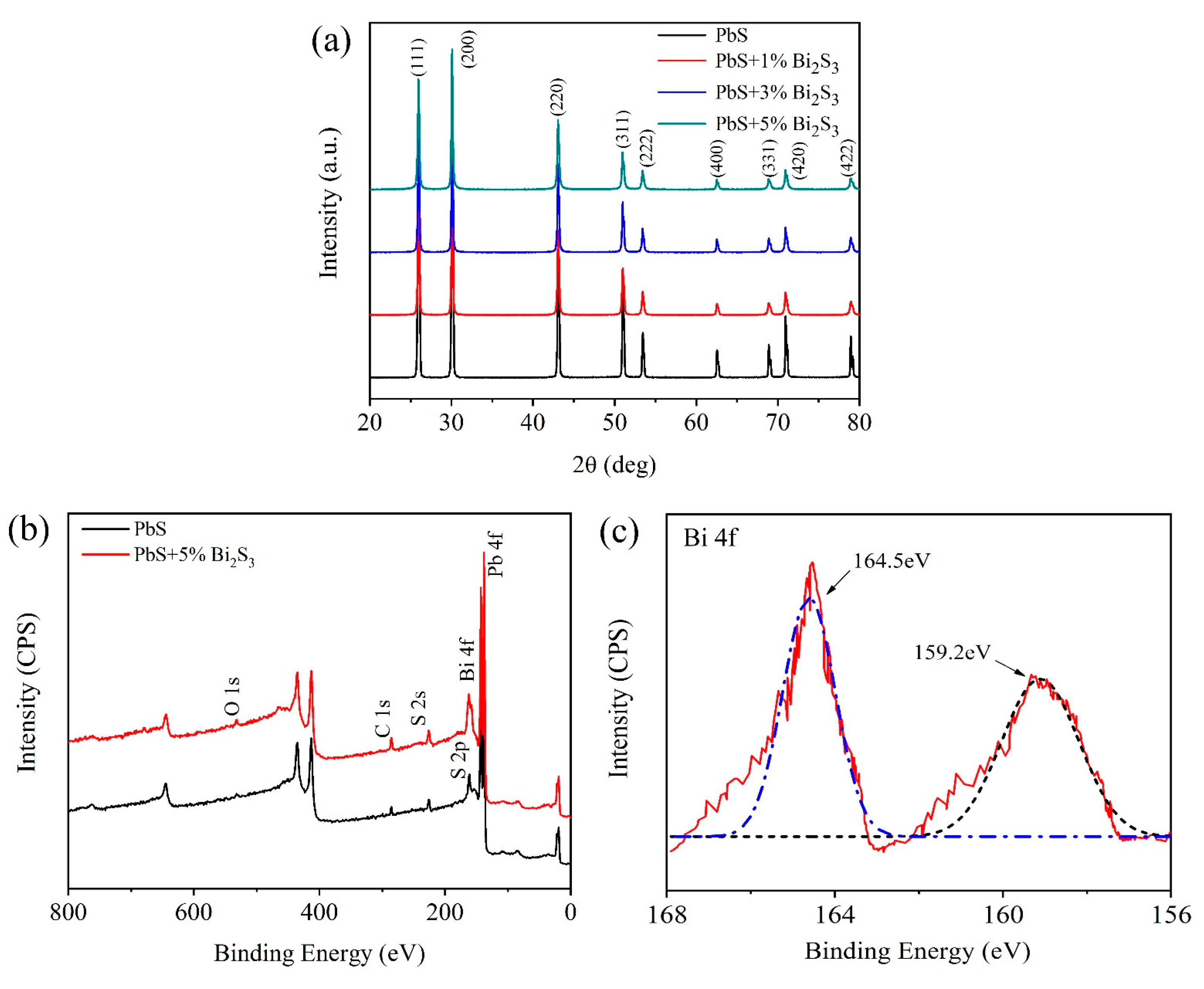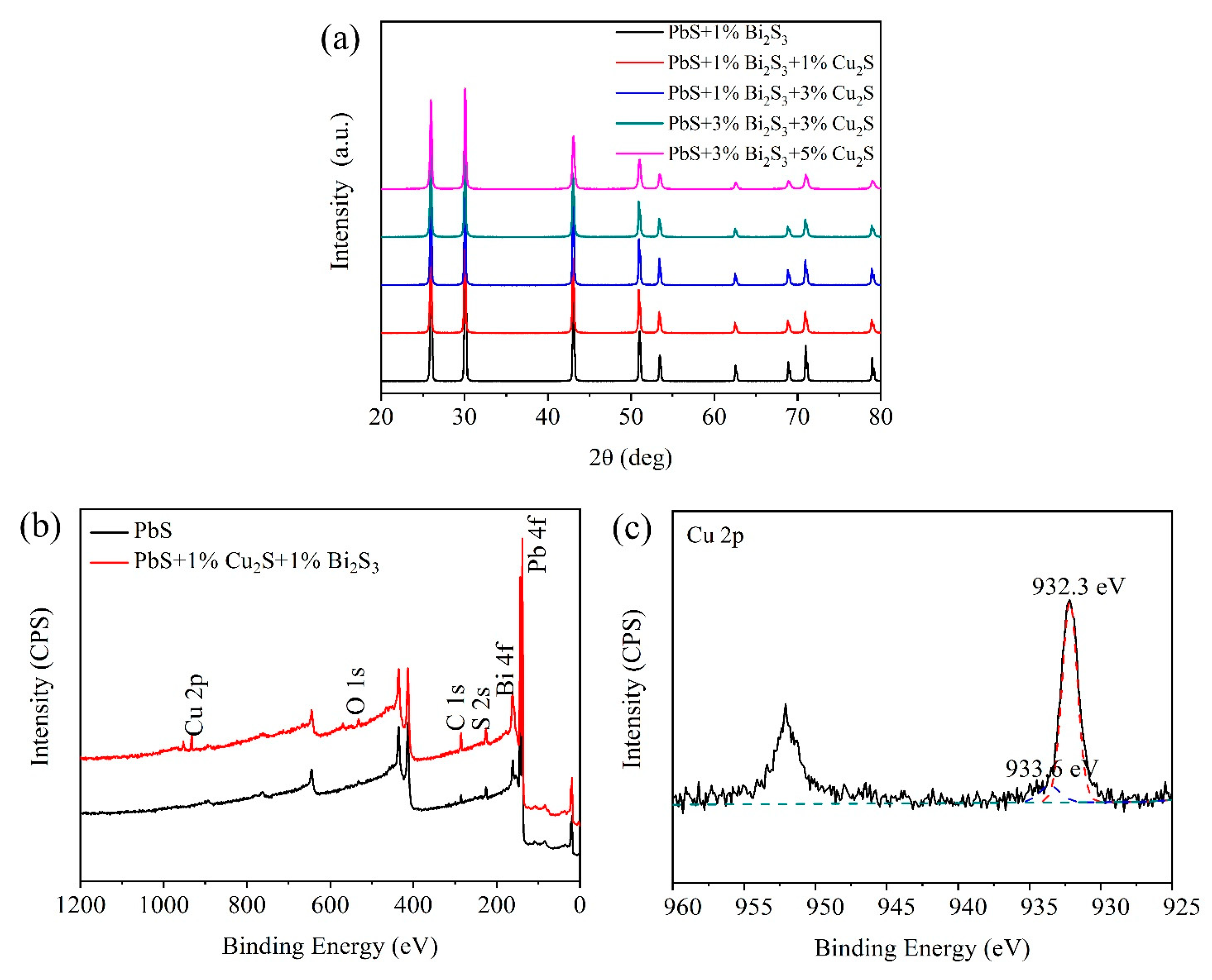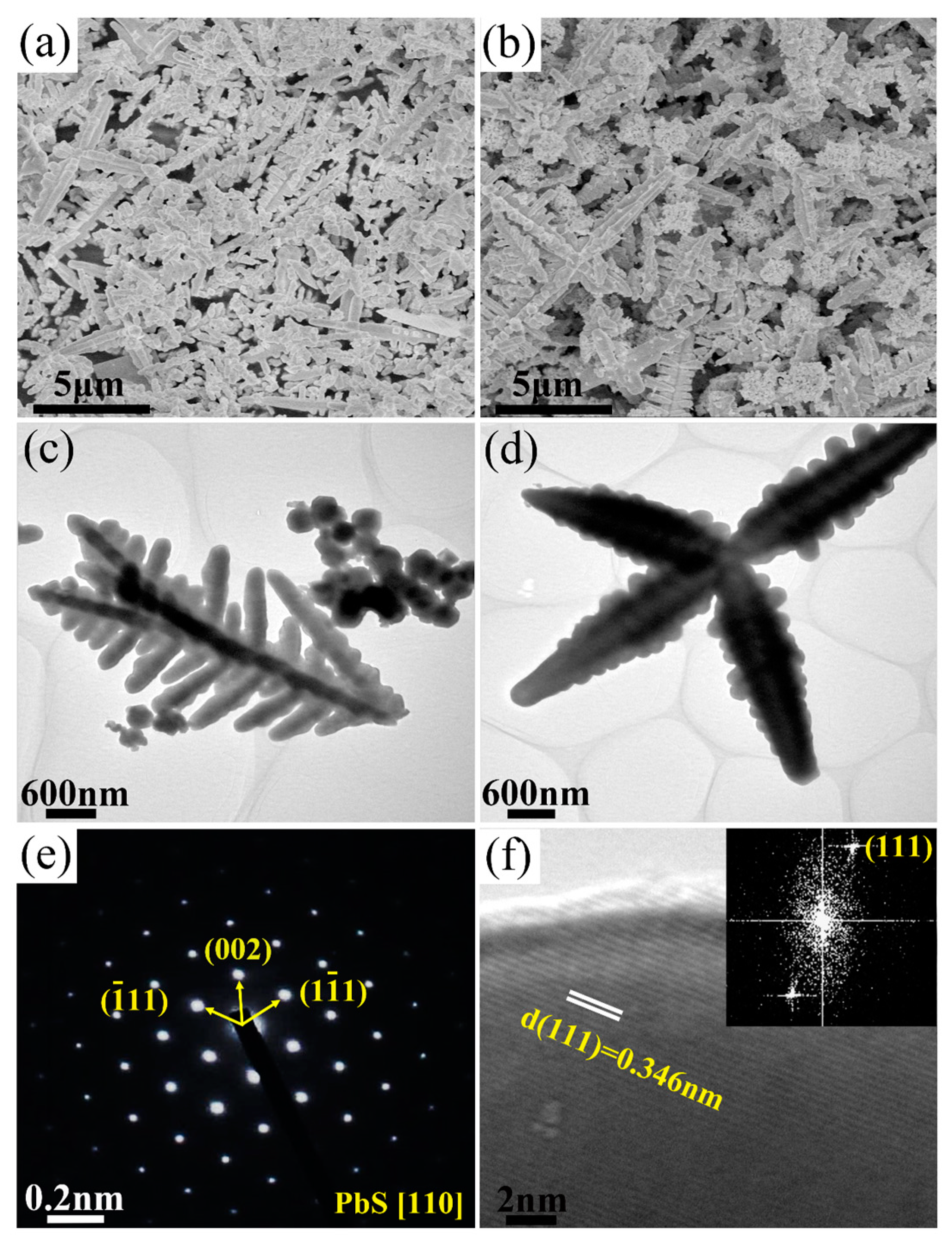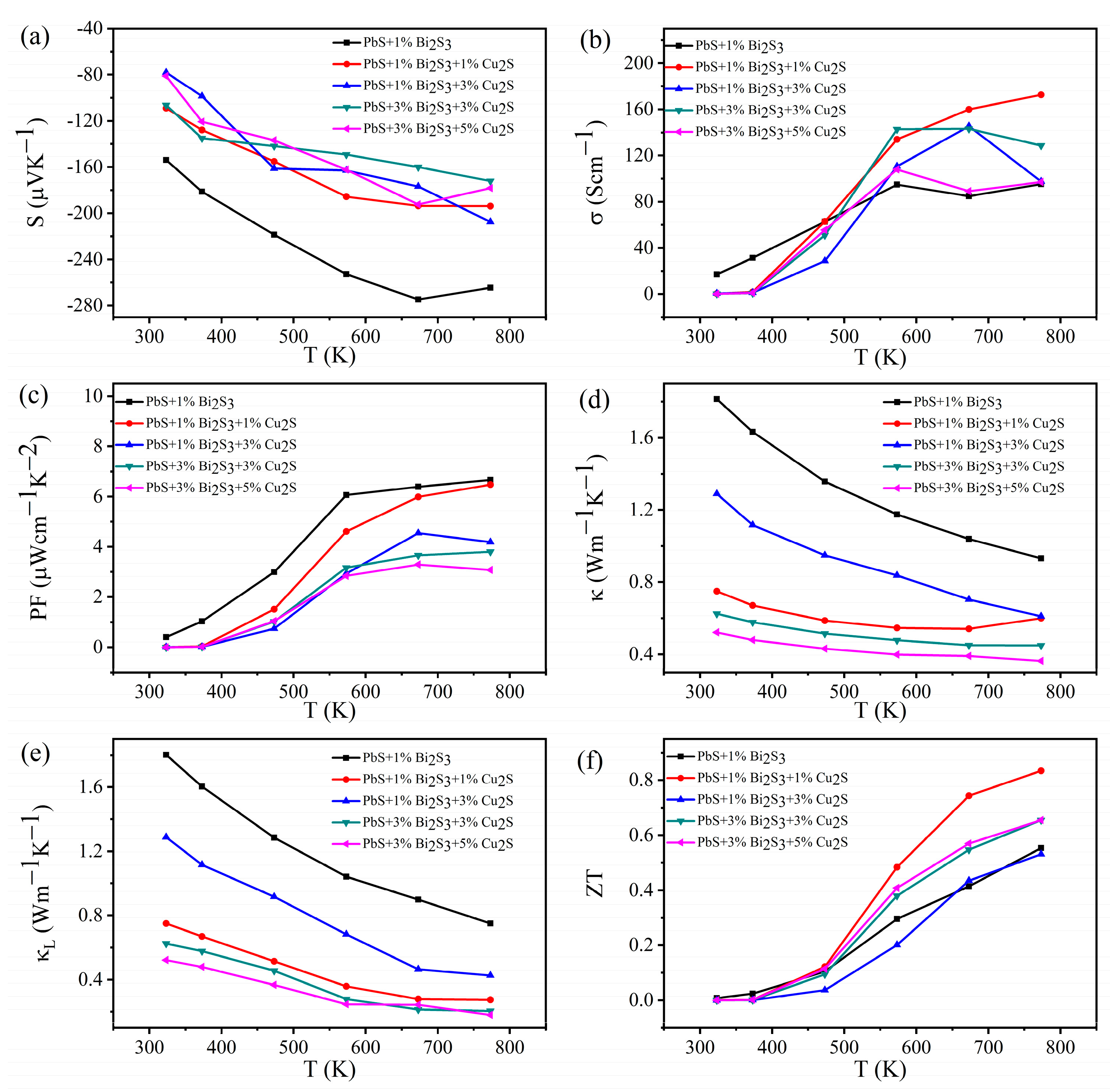Thermoelectric Properties of PbS Doped with Bi2S3 and Cu2S Prepared by Hydrothermal Synthesis and Spark Plasma Sintering
Abstract
1. Introduction
2. Materials and Methods
3. Results and Discussion
3.1. Thermoelectric Properties of PbS Doped with Bi2S3
3.2. Thermoelectric Properties of PbS Co-Doped with Bi2S3 and Cu2S
4. Conclusions
Author Contributions
Funding
Data Availability Statement
Conflicts of Interest
References
- Liu, W.S.; Kim, H.S.; Chen, S.; Jie, Q.; Lv, B.; Yao, M.L.; Ren, Z.S.; Opeil, C.P.; Wilson, S.; Chu, C.W. n-type thermoelectric material Mg2Sn0. 75Ge0. 25 for high power generation. Proc. Natl. Acad. Sci. USA 2015, 112, 3269–3274. [Google Scholar] [CrossRef]
- Zhao, L.D.; Kanatzidis, M.G. An overview of advanced thermoelectric materials. J. Mater. 2016, 2, 101–103. [Google Scholar] [CrossRef]
- He, J.; Tritt, T.M. Advances in thermoelectric materials research: Looking back and moving forward. Science 2017, 357, eaak9997. [Google Scholar] [CrossRef]
- Su, X.L.; Wei, P.; Li, H.; Liu, W.; Yan, Y.G.; Li, P.; Su, C.Q.; Xie, C.J.; Zhao, W.Y.; Zhai, P.C. Multi-scale microstructural thermoelectric materials: Transport behavior, non-equilibrium preparation, and applications. Adv. Mater. 2017, 29, 1602013. [Google Scholar] [CrossRef] [PubMed]
- Zhao, W.Y.; Liu, Z.Y.; Sun, Z.G.; Zhang, Q.J.; Wei, P.; Mu, X.; Zhou, H.Y.; Li, C.C.; Ma, S.F.; He, D.Q. Superparamagnetic enhancement of thermoelectric performance. Nature 2017, 549, 247–251. [Google Scholar] [CrossRef] [PubMed]
- Hamawandi, B.; Mansouri, H.; Ballikaya, S.; Demirci, Y.; Orlovska, M.; Bolghanabadi, N.; Sajjadi, S.A.; Toprak, M.S. A comparative study on the thermoelectric properties of bismuth chalcogenide alloys synthesized through mechanochemical alloying and microwave-assisted solution synthesis routes. Front. Mater. 2020, 7, 569723. [Google Scholar] [CrossRef]
- Pei, J.; Cai, B.W.; Zhuang, H.L.; Li, J.F. Bi2Te3-based applied thermoelectric materials: Research advances and new challenges. Natl. Sci. Rev. 2020, 7, 1856–1858. [Google Scholar] [CrossRef]
- Demirci, Y.; Yusuf, A.; Hamawandi, B.; Toprak, M.S.; Ballikaya, S. The effect of crystal mismatch on the thermoelectric performance enhancement of nano Cu2Se. Front. Mater. 2021, 7, 581138. [Google Scholar] [CrossRef]
- Li, J.; Huckleby, A.B.; Zhang, M. Polymer-based thermoelectric materials: A review of power factor improving strategies. J. Mater. 2022, 8, 204–220. [Google Scholar] [CrossRef]
- DiSalvo, F.J. Thermoelectric cooling and power generation. Science 1999, 285, 703–706. [Google Scholar] [CrossRef]
- Tritt, T.M.; Subramanian, M. Thermoelectric materials, phenomena, and applications: A bird’s eye view. MRS Bull. 2006, 31, 188–198. [Google Scholar] [CrossRef]
- Nakamura, Y. Nanostructure design for drastic reduction of thermal conductivity while preserving high electrical conductivity. Sci. Technol. Adv. Mat. 2018, 19, 31–43. [Google Scholar] [CrossRef]
- Li, J.F.; Liu, W.S.; Zhao, L.D.; Zhou, M. High-performance nanostructured thermoelectric materials. NPG Asia Mater. 2010, 2, 152–158. [Google Scholar] [CrossRef]
- Wolf, M.; Menekse, K.; Mundstock, A.; Hinterding, R.; Nietschke, F.; Oeckler, O.; Feldhoff, A. Low thermal conductivity in thermoelectric oxide-based multiphase composites. J. Electron. Mater. 2019, 48, 7551–7561. [Google Scholar] [CrossRef]
- Fortulan, R.; Aminorroaya Yamini, S. Recent progress in multiphase thermoelectric materials. Materials 2021, 14, 6059. [Google Scholar] [CrossRef]
- Zhang, Y.X.; Yang, T.Y.; Wang, Z.Y.; Feng, J.; Ge, Z.H. Highly enhanced stability and thermoelectric performance of copper sulfides-based composites by multiphase engineering. Mater. Today Phys. 2022, 27, 100808. [Google Scholar] [CrossRef]
- Harman, T.; Taylor, P.; Walsh, M.; LaForge, B. Quantum dot superlattice thermoelectric materials and devices. Science 2002, 297, 2229–2232. [Google Scholar] [CrossRef] [PubMed]
- Hochbaum, A.I.; Chen, R.K.; Delgado, R.D.; Liang, W.J.; Garnett, E.C.; Najarian, M.; Majumdar, A.; Yang, P.D. Enhanced thermoelectric performance of rough silicon nanowires. Nature 2008, 451, 163–167. [Google Scholar] [CrossRef]
- Liu, M.X.; Yazdani, N.; Yarema, M.; Jansen, M.; Wood, V.; Sargent, E.H. Colloidal quantum dot electronics. Nat. Electron. 2021, 4, 548–558. [Google Scholar] [CrossRef]
- Putri, Y.E.; Said, S.M.; Diantoro, M. Nanoarchitectured titanium complexes for thermal mitigation in thermoelectric materials. Renew. Sust. Energ. Rev. 2019, 101, 346–360. [Google Scholar] [CrossRef]
- Singh, D.; Ahuja, R. Dimensionality effects in high-performance thermoelectric materials: Computational and experimental progress in energy harvesting applications. WIRES Comput. Mol. Sci. 2022, 12, e1547. [Google Scholar] [CrossRef]
- Li, Y.; Wang, G.L.; Akbari-Saatlu, M.; Procek, M.; Radamson, H.H. Si and SiGe nanowire for micro-thermoelectric generator: A review of the current state of the art. Front. Mater. 2021, 8, 611078. [Google Scholar] [CrossRef]
- Lin, Y.M.; Dresselhaus, M. Thermoelectric properties of superlattice nanowires. Phys. Rev. B 2003, 68, 075304. [Google Scholar] [CrossRef]
- Caballero-Calero, O.; Martín-González, M. Thermoelectric nanowires: A brief prospective. Scr. Mater. 2016, 111, 54–57. [Google Scholar] [CrossRef]
- Chen, R.K.; Lee, J.; Lee, W.; Li, D.Y. Thermoelectrics of nanowires. Chem. Rev. 2019, 119, 9260–9302. [Google Scholar] [CrossRef]
- Domínguez-Adame, F.; Martín-González, M.; Sánchez, D.; Cantarero, A. Nanowires: A route to efficient thermoelectric devices. Phys. E 2019, 113, 213–225. [Google Scholar] [CrossRef]
- Snyder, G.J.; Toberer, E.S. Complex thermoelectric materials. Nat. Mater. 2008, 7, 105–114. [Google Scholar] [CrossRef]
- Alam, H.; Ramakrishna, S. A review on the enhancement of figure of merit from bulk to nano-thermoelectric materials. Nano Energy 2013, 2, 190–212. [Google Scholar] [CrossRef]
- Hua, C.Y.; Minnich, A.J. Importance of frequency-dependent grain boundary scattering in nanocrystalline silicon and silicon-germanium thermoelectrics. Semicond. Sci. Technol. 2014, 29, 124004. [Google Scholar] [CrossRef]
- Cao, J.Y.; Ekren, D.; Peng, Y.D.; Azough, F.; Kinloch, I.A.; Freer, R. Modulation of charge transport at grain boundaries in SrTiO3: Toward a high thermoelectric power factor at room temperature. ACS Appl. Mater. Interfaces 2021, 13, 11879–11890. [Google Scholar] [CrossRef]
- Heremans, J.P.; Jovovic, V.; Toberer, E.S.; Saramat, A.; Kurosaki, K.; Charoenphakdee, A.; Yamanaka, S.; Snyder, G.J. Enhancement of thermoelectric efficiency in PbTe by distortion of the electronic density of states. Science 2008, 321, 554–557. [Google Scholar] [CrossRef]
- Zhou, M.; Li, J.F.; Kita, T. Nanostructured AgPbmSbTem+2 system bulk materials with enhanced thermoelectric performance. J. Am. Chem. Soc. 2008, 130, 4527–4532. [Google Scholar] [CrossRef]
- Mei, D.Q.; Li, Y.; Yao, Z.H.; Wang, H.; Zhu, T.J.; Chen, S.C. Enhanced thermoelectric performance of n-type PbTe bulk materials fabricated by semisolid powder processing. J. Alloys Compd. 2014, 609, 201–205. [Google Scholar] [CrossRef]
- Jiang, B.B.; Liu, X.X.; Wang, Q.; Cui, J.; Jia, B.H.; Zhu, Y.K.; Feng, J.H.; Qiu, Y.; Gu, M.; Ge, Z.H. Realizing high-efficiency power generation in low-cost PbS-based thermoelectric materials. Energ. Environ. Sci. 2020, 13, 579–591. [Google Scholar] [CrossRef]
- Liu, H.T.; Sun, Q.; Zhong, Y.; Deng, Q.; Gan, L.; Lv, F.L.; Shi, X.L.; Chen, Z.G.; Ang, R. High-performance in n-type PbTe-based thermoelectric materials achieved by synergistically dynamic doping and energy filtering. Nano Energy 2022, 91, 106706. [Google Scholar] [CrossRef]
- Xiao, Y.; Wu, H.J.; Shi, H.N.; Xu, L.Q.; Zhu, Y.K.; Qin, Y.X.; Peng, G.Y.; Zhang, Y.; Ge, Z.H.; Ding, X.D. High-ranged ZT value promotes thermoelectric cooling and power generation in n-Type PbTe. Adv. Energy Mater. 2022, 12, 2200204. [Google Scholar] [CrossRef]
- Androulakis, J.; Todorov, I.; He, J.Q.; Chung, D.Y.; Dravid, V.; Kanatzidis, M. Thermoelectrics from abundant chemical elements: High-performance nanostructured PbSe-PbS. J. Am. Chem. Soc. 2011, 133, 10920–10927. [Google Scholar] [CrossRef]
- Ge, Z.H.; Zhao, L.D.; Wu, D.; Liu, X.Y.; Zhang, B.P.; Li, J.F.; He, J.Q. Low-cost, abundant binary sulfides as promising thermoelectric materials. Mater. Today 2016, 19, 227–239. [Google Scholar] [CrossRef]
- Yang, J.; Zhang, X.Z.; Liu, G.W.; Zhao, L.J.; Liu, J.L.; Shi, Z.Q.; Ding, J.N.; Qiao, G.J. Multiscale structure and band configuration tuning to achieve high thermoelectric properties in n-type PbS bulks. Nano Energy 2020, 74, 104826. [Google Scholar] [CrossRef]
- Zhao, L.D.; Lo, S.H.; He, J.Q.; Li, H.; Biswas, K.; Androulakis, J.; Wu, C.; Hogan, T.P.; Chung, D.Y.; Dravid, V.P. High performance thermoelectrics from earth-abundant materials: Enhanced figure of merit in PbS by second phase nanostructures. J. Am. Chem. Soc. 2011, 133, 20476–20487. [Google Scholar] [CrossRef] [PubMed]
- Sun, S.S.; Han, Q.F.; Wu, X.D.; Zhu, J.W.; Wang, X. The facile synthesis of PbS cubes and Bi2S3 nanoflowers from molecular precursors at room temperature. Mater. Lett. 2011, 65, 3344–3347. [Google Scholar] [CrossRef]
- Zhu, Z.Y.; Tiwari, J.; Feng, T.L.; Shi, Z.; Lou, Y.; Xu, B. High thermoelectric properties with low thermal conductivity due to the porous structure induced by the dendritic branching in n-type PbS. Nano Res. 2022, 15, 4739–4746. [Google Scholar] [CrossRef]
- Xiang, J.H.; Cao, H.Q.; Wu, Q.Z.; Zhang, S.C.; Zhang, X.R. L-cysteine-assisted self-assembly of complex PbS structures. Cryst. Growth Des. 2008, 8, 3935–3940. [Google Scholar] [CrossRef]
- Wagle, D.V.; Zhao, H.; Baker, G.A. Deep eutectic solvents: Sustainable media for nanoscale and functional materials. Acc. Chem. Res. 2014, 47, 2299–2308. [Google Scholar] [CrossRef] [PubMed]
- Lee, S.M.; Jun, Y.W.; Cho, S.N.; Cheon, J. Single-crystalline star-shaped nanocrystals and their evolution: Programming the geometry of nano-building blocks. J. Am. Chem. Soc. 2002, 124, 11244–11245. [Google Scholar] [CrossRef] [PubMed]
- Sathyamoorthy, R.; Kungumadevi, L. Facile synthesis of PbS nanorods induced by concentration difference. Adv. Powder Technol. 2015, 26, 355–361. [Google Scholar] [CrossRef]
- Li, C.; Shi, G.; Xu, H.Y.; Guang, S.Y.; Yin, R.H.; Song, Y.L. Nonlinear optical properties of the PbS nanorods synthesized via surfactant-assisted hydrolysis. Mater. Lett. 2007, 61, 1809–1811. [Google Scholar] [CrossRef]
- Querejeta-Fernández, A.; Hernández-Garrido, J.C.; Yang, H.X.; Zhou, Y.L.; Varela, A.; Parras, M.; Calvino-Gámez, J.J.; González-Calbet, J.M.; Green, P.F.; Kotov, N.A. Unknown aspects of self-assembly of PbS microscale superstructures. ACS Nano 2012, 6, 3800. [Google Scholar] [CrossRef]
- Ni, Y.H.; Liu, H.J.; Wang, F.; Liang, Y.Y.; Hong, J.M.; Ma, X.; Xu, Z. Shape controllable preparation of PbS crystals by a simple aqueous phase route. Cryst. Growth Des. 2004, 4, 759–764. [Google Scholar] [CrossRef]
- Quan, Z.W.; Li, C.X.; Zhang, X.M.; Yang, J.; Yang, P.P.; Zhang, C.M.; Lin, J. Polyol-mediated synthesis of PbS crystals: Shape evolution and growth mechanism. Cryst. Growth Des. 2008, 8, 2384–2392. [Google Scholar] [CrossRef]
- Ibáñez, M.; Zamani, R.; Gorsse, S.; Fan, J.D.; Ortega, S.; Cadavid, D.; Morante, J.R.; Arbiol, J.; Cabot, A. Core-shell nanoparticles as building blocks for the bottom-up production of functional nanocomposites: PbTe-PbS thermoelectric properties. ACS Nano 2013, 7, 2573–2586. [Google Scholar] [CrossRef] [PubMed]
- Zhao, L.D.; He, J.Q.; Hao, S.Q.; Wu, C.; Hogan, T.P.; Wolverton, C.; Dravid, V.P.; Kanatzidis, M.G. Raising the thermoelectric performance of p-type PbS with endotaxial nanostructuring and valence-band offset engineering using CdS and ZnS. J. Am. Chem. Soc. 2012, 134, 16327–16336. [Google Scholar] [CrossRef]
- Chang, C.; Xiao, Y.; Zhang, X.; Pei, Y.L.; Li, F.; Ma, S.L.; Yuan, B.F.; Liu, Y.; Gong, S.K.; Zhao, L.D. High performance thermoelectrics from earth-abundant materials: Enhanced figure of merit in PbS through nanostructuring grain size. J. Alloys Compd. 2016, 664, 411–416. [Google Scholar] [CrossRef]
- Ou, X.; Shuai, Y.; Luo, W.B.; Siles, P.F.; Kögler, R.; Fiedler, J.; Reuther, H.; Zhou, S.Q.; Hübner, R.; Facsko, S. Forming-free resistive switching in multiferroic BiFeO3 thin films with enhanced nanoscale shunts. ACS Appl. Mater. Inter. 2013, 5, 12764–12771. [Google Scholar] [CrossRef]
- Zhang, Y.L.; Qi, J.; Wang, Y.H.; Tian, Y.; Zhang, J.K.; Hu, T.J.; Wei, M.B.; Liu, Y.Q.; Yang, J.H. Tuning magnetic properties of BiFeO3 thin films by controlling Mn doping concentration. Ceram. Int. 2018, 44, 6054–6061. [Google Scholar] [CrossRef]
- Ran, J.H.; Chen, H.B.; Bai, X.; Bi, S.G.; Jiang, H.Y.; Cai, G.M.; Cheng, D.S.; Wang, X. Immobilizing CuO/BiVO4 nanocomposite on PDA-templated cotton fabric for visible light photocatalysis, antimicrobial activity and UV protection. Appl. Surf. Sci. 2019, 493, 1167–1176. [Google Scholar] [CrossRef]
- Johnsen, S.; He, J.Q.; Androulakis, J.; Dravid, V.P.; Todorov, I.; Chung, D.Y.; Kanatzidis, M.G. Nanostructures boost the thermoelectric performance of PbS. J. Am. Chem. Soc. 2011, 133, 3460–3470. [Google Scholar] [CrossRef]
- Buscaglia, M.T.; Maglia, F.; Anselmi-Tamburini, U.; Marre, D.; Pallecchi, I.; Ianculescu, A.; Canu, G.; Viviani, M.; Fabrizio, M.; Buscaglia, V. Effect of nanostructure on the thermal conductivity of La-doped SrTiO3 ceramics. J. Eur. Ceram. Soc. 2014, 34, 307–316. [Google Scholar] [CrossRef]
- Lin, C.-C.; Lydia, R.; Yun, J.H.; Lee, H.S.; Rhyee, J.S. Extremely low lattice thermal conductivity and point defect scattering of phonons in Ag-doped (SnSe)1–x(SnS)x compounds. Chem. Mater. 2017, 29, 5344–5352. [Google Scholar] [CrossRef]
- El-Khouly, A.; Novitskii, A.; Adam, A.; Sedegov, A.; Kalugina, A.; Pankratova, D.; Karpenkov, D.; Khovaylo, V. Transport and thermoelectric properties of Hf-doped FeVSb half-Heusler alloys. J. Alloys Compd. 2020, 820, 153413. [Google Scholar] [CrossRef]
- Wang, W.; Luo, S.J.; Xian, C. Enhanced thermoelectric properties of hydrothermal synthesized BiCl3/Bi2S3 composites. J. Inorg. Mater. 2019, 34, 328–334. [Google Scholar] [CrossRef]
- You, L.; Liu, Y.F.; Li, X.; Nan, P.F.; Ge, B.H.; Jiang, Y.; Luo, P.F.; Pan, S.S.; Pei, Y.Z.; Zhang, W.Q. Boosting the thermoelectric performance of PbSe through dynamic doping and hierarchical phonon scattering. Energ. Environ. Sci. 2018, 11, 1848–1858. [Google Scholar] [CrossRef]
- You, L.; Zhang, J.Y.; Pan, S.S.; Jiang, Y.; Wang, K.; Yang, J.; Pei, Y.Z.; Zhu, Q.; Agne, M.T.; Snyder, G.J. Realization of higher thermoelectric performance by dynamic doping of copper in n-type PbTe. Energ. Environ. Sci. 2019, 12, 3089–3098. [Google Scholar] [CrossRef]
- Qin, Y.X.; Hong, T.; Qin, B.C.; Wang, D.Y.; He, W.K.; Gao, X.; Xiao, Y.; Zhao, L.D. Contrasting Cu roles lead to high ranged thermoelectric performance of PbS. Adv. Funct. Mater. 2021, 31, 2102185. [Google Scholar] [CrossRef]






| Sample | T (K) | S (μV K−1) | σ (S cm−1) | PF (μW cm−1 K−2) | (W m−1 K−1) | (W m−1 K−1) | ZTmax |
|---|---|---|---|---|---|---|---|
| PbS | 758 | −360.0 | 35.2 | 4.56 | 1.21 | 1.14 | 0.29 |
| PbS + 1% Bi2S3 | 773 | −264.5 | 95.3 | 6.67 | 0.93 | 0.75 | 0.55 |
| PbS + 3% Bi2S3 | 773 | −187.9 | 136.6 | 4.82 | 0.79 | 0.53 | 0.47 |
| PbS + 5% Bi2S3 | 773 | −178.8 | 139.2 | 4.45 | 0.87 | 0.60 | 0.40 |
| PbS + 1% Bi2S3 + 1% Cu2S | 773 | −193.7 | 172.6 | 6.48 | 0.60 | 0.27 | 0.83 |
| PbS + 1% Bi2S3 + 3% Cu2S | 773 | −207.4 | 97.5 | 4.19 | 0.61 | 0.43 | 0.53 |
| PbS + 3% Bi2S3 + 3% Cu2S | 773 | −172.0 | 128.7 | 3.81 | 0.45 | 0.21 | 0.66 |
| PbS + 3% Bi2S3 + 5% Cu2S | 773 | −178.1 | 97.0 | 3.08 | 0.36 | 0.18 | 0.65 |
Disclaimer/Publisher’s Note: The statements, opinions and data contained in all publications are solely those of the individual author(s) and contributor(s) and not of MDPI and/or the editor(s). MDPI and/or the editor(s) disclaim responsibility for any injury to people or property resulting from any ideas, methods, instructions or products referred to in the content. |
© 2023 by the authors. Licensee MDPI, Basel, Switzerland. This article is an open access article distributed under the terms and conditions of the Creative Commons Attribution (CC BY) license (https://creativecommons.org/licenses/by/4.0/).
Share and Cite
Wang, W.; Xian, C.; Ou, Y.; He, Z.; Xie, S. Thermoelectric Properties of PbS Doped with Bi2S3 and Cu2S Prepared by Hydrothermal Synthesis and Spark Plasma Sintering. Crystals 2023, 13, 764. https://doi.org/10.3390/cryst13050764
Wang W, Xian C, Ou Y, He Z, Xie S. Thermoelectric Properties of PbS Doped with Bi2S3 and Cu2S Prepared by Hydrothermal Synthesis and Spark Plasma Sintering. Crystals. 2023; 13(5):764. https://doi.org/10.3390/cryst13050764
Chicago/Turabian StyleWang, Wei, Cong Xian, Yun Ou, Zhijian He, and Shuhong Xie. 2023. "Thermoelectric Properties of PbS Doped with Bi2S3 and Cu2S Prepared by Hydrothermal Synthesis and Spark Plasma Sintering" Crystals 13, no. 5: 764. https://doi.org/10.3390/cryst13050764
APA StyleWang, W., Xian, C., Ou, Y., He, Z., & Xie, S. (2023). Thermoelectric Properties of PbS Doped with Bi2S3 and Cu2S Prepared by Hydrothermal Synthesis and Spark Plasma Sintering. Crystals, 13(5), 764. https://doi.org/10.3390/cryst13050764






